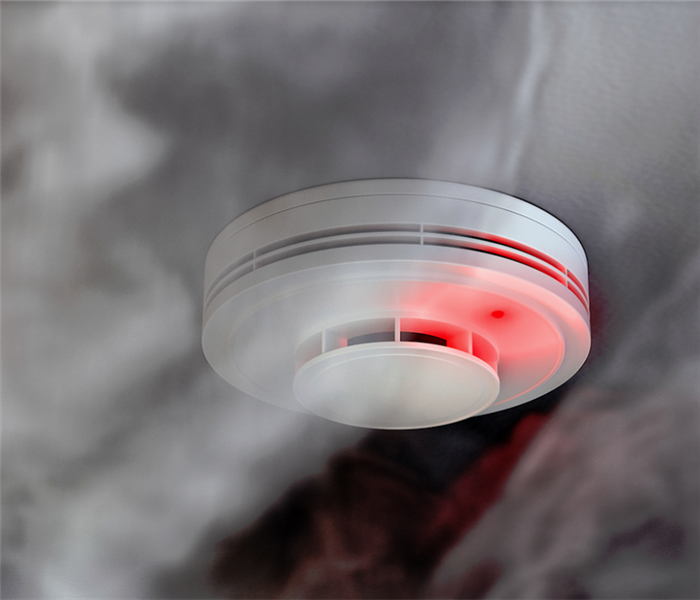Are Smoke and Soot Damages in Sparta Restorable With Cleaning?
10/11/2020 (Permalink)
 Did your home suffer recent fire damage? Contact SERVPRO for effective fire damage remediation services.
Did your home suffer recent fire damage? Contact SERVPRO for effective fire damage remediation services.
The Result of Fire Damage Can Be Extensive Soiling, Soots, and Staining. SERVPRO Can Arrest the Development of Permanent Soils in your Sparta Home.
Does bleach work on soot and smoke residues?
Getting rid of spots and stains in your Sparta home after a fire event can be challenging. Bleaches are widely available household products that seek to reverse the coloration of stains rather than remove them. Color stains occur because soils chemically bond with the surfaces they contact. These chemical reactions can occur under the higher temperatures of a fire. When using bleaches, it is crucial to avoid application on dyed materials as bleach can remove dye and soils. Reducing bleaches are useful when cleaning soots or smokes from hardwoods. These bleaches can strip the surface of the wood. It can then be refinished to ensure a uniform end product. While bleaching products can be practical in fire restoration, especially for protein fires, they are rarely the primary cleaning method SERVPRO uses to clean properties with soot and smoke soils.
Why are soot and smoke residues challenging to eliminate?
A property with fire damage in Sparta is likely to have a mix of soils and soots. Some of these soils may be easier to remove using dry cleaning or vacuuming. Other soots may bond to surfaces becoming tough to separate. SERVPRO technicians need to be ready to choose the right cleaning method to separate soots from the surface. The correct technique depends mostly on the type of soots as well as the type of surface. In some situations, a quick solution is to lubricate the surface, which can break the bond. A typical example of lubrication could be using detergent, which both lubricates and emulsifies the soils on the surface. Our technicians only opt for detergents in situations where a pre-test result shows water-based stain composition. Using a detergent on a wet or oily smoke can make matters worse.
What are the best methods for separating bonded soots from surfaces?
- Chemical actions which can alter the composition of soots or stains
- Suspension and dispersion are among the most common, which dissolve soots from a surface.
- Mechanical cleaning avoids using chemicals in favor of friction that can break the bond between soot and surface through repetitive agitation.
Can materials suffer damage from cleaning agents?
A vital role of a restoration technician is to understand how cleaning methods affect surface materials. Aggressive action, whether chemical or mechanical, generally gets the fastest results; however, certain materials can become damaged using an overly aggressive approach. There is a careful balancing act that fire and smoke damage restoration technicians (FSRT) apply when cleaning a surface. These materials may include items like marble, fabrics, textiles, and other porous or semi-porous materials. Many materials in your home are restorable by applying proper chemical action, so SERVPRO operates with a restore over replace mentality.
What techniques are useful for surface cleaning?
- Spray and wiping is a non-aggressive, quick-drying technique applicable to most surfaces.
- Foam Cleaning may take longer but is useful for materials that could become damaged by excess water or temperature.
- Shampooing is useful for upholstery and textiles to remove both stains and odors from the furniture.
What cleaning products clear away soot from fragile surfaces?
There are likely to be many fragile materials in your Sparta home. These surfaces require extra care and attention to avoid causing secondary harm during the cleaning process. Absorption is a method that we use for materials that are too fragile for solvents or excessive moisture. To clean a delicate surface, SERVPRO technicians apply an absorbent powder. These draw water and soils and residues into the powder, which can then be extracted using vacuum techniques. We commonly use absorbent powders on semi-porous materials like concrete, brickwork, marble, and textiles as these materials typically respond poorly to high volume wet washing. Absorbent powders are combinable with solvents, which produce a thick paste that can dry on the material before being vacuumed.
What consideration is there for applying chemical cleaning agents?
- The type of surface or material, including dye, fabric composition, and porosity which can affect the impact of a chemical cleaning agent
- The aggressiveness of the cleaning action being applied or the pH balance of the solvent/cleaning agent
- Results of a pre-test on a discrete area of the fabric or material which can reveal whether a solvent causes any unnecessary damage
- Always consult the manufacturer guidance for both the cleaning product being used, correct dilution, and the material's recommended products.
Getting rid of soils, soots, and smoke residues can be a challenge and, without effective administration, could cause further harm to the materials you are cleaning. For expert advice, contact SERVPRO of Cumberland, Morgan & White Counties at (931) 250-5333.





 24/7 Emergency Service
24/7 Emergency Service